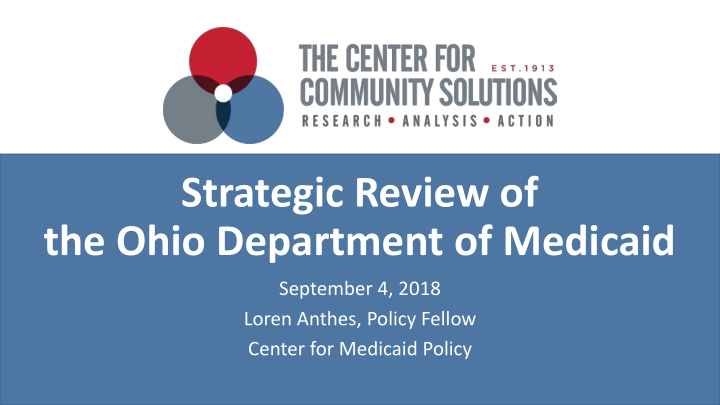



Strategic Review of the Ohio Department of Medicaid September 4, 2018 Loren Anthes, Policy Fellow Center for Medicaid Policy
Strategic Recommendations 1. Maintain Current Value-Based Efforts 2. Revise MCO Contracts to Account for Social Determinants 3. Increase Program Integrity 4. Build Consumer-Focused Value 5. Look at Non-Medicaid Policies to Affect Health KEY RESOURCE 2
Recommendation 1: Maintain Current Value Efforts • Continue the SIM Work • CPC Results Improvements in primary care delivery, including care management for high-risk patients, enhanced access and improved • coordination of care transitions. Slowed growth in emergency department visits by 2 percent in CPC practices, relative to comparison practices • Did not slow Medicare spending – more analysis in Medicaid needed • • Episodes Reductions in asthma (21%) and COPD acute exacerbation (18%) spending • Increases in “commendable” quality level • • Maintain P4P Program in Managed Care • Increasing risk, considering other options (loss ratio) could be considered • Maintain Current Eligibility Levels and Processes in Expansion • Outcomes of expansion include lower cost, better utilization, greater provider participation, increased economic mobility and reduction in social service need • Remove all specific ORC controls over rate development CPC: Health Affairs, June 2018: https://www.healthaffairs.org/doi/10.1377/hlthaff.2017.1678 Episodes: http://www.healthpolicyohio.org/wp-content/uploads/2018/04/Moody.pdf Expansion: http://medicaid.ohio.gov/Portals/0/Resources/Reports/Annual/Group-VIII-Final-Report.pdf
Recommendation 2: Revise Managed Care Contracts to Address Social Determinants • Managed Care quality is more simplified and improving, but needs refining • Plan performance is underwhelming in a number of areas • Medical Loss Ratio Review • Review MCOs current MLR to ensure compliance with 85% standard • This threshold can be increased and put at risk • Other Policy Options • Classify Certain Social Services Under Medicaid Plan • Pursue 1115 to establish Coordinated Care Organizations (Oregon Model) or consider disrupting MCO market by opening up Medicaid ACOs to hospitals • Value-based purchasing arrangements to require social service investments • P4P linkage • Allow “Quality Improvement” activities related to non-benefits to qualify • Reward effective interventions with higher rates Medicaid Coverage of Social Interventions, The Milbank Memorial Fund: https://www.milbank.org/publications/medicaid-coverage-social-interventions-road-map-states/
Recommendation 3: Increase Program Integrity Efforts • Enhance Efforts to Reducing Fraud, Waste and Abuse • Examining utilization management tools (Prior Authorization, Rx Lock-In) • Audit Supplemental Payments and Realign Toward 2025 Standard for Value • Develop Regulatory Capture Strategy • Review medical boards with state pricing influence and increase ethics/disclosure requirements (e.g. Preferred Drug List) • Make Quality and Cost Transparency a Priority • Require hospitals publish charge master online, audit, and publish regular reports • Publish quality data for hospitals, nursing homes, etc., online in a consumer friendly format • Re-Examine Community Benefit Standards and Audit “Medicaid shortfall” Fraud, Waste & Abuse: Link Supplemental Payments: https://www.commonwealthfund.org/publications/fund-reports/2016/nov/integrating-medicaid-supplemental-payments-value-based PDL: https://www.beckershospitalreview.com/supply-chain/texas-aims-to-curb-drugmaker-influence-on-medicaid-preferred-med-decisions.html Chargemaster: https://www.healthaffairs.org/doi/10.1377/hlthaff.2016.0093 Quality Reporting: https://www.healthaffairs.org/doi/10.1377/hlthaff.2016.0093; Community Benefit: https://nashp.org/states-work-to-hold-hospitals-accountable-for-community-benefits-spending/
Recommendation 4: Build Consumer-Focused Value • Revise Rate Development and Medical Education Financing to Address Workforce Needs • Focus on professions associated with ABD (long term care, developmental disabilities, behavioral health) • Enable professions focused on primary care, including a review of scope of practice laws that act as barriers to entry for medically equivalent services • Revisit GME and Capital Add-on Payments and Align with Value • Consider Site-Neutrality for Medicaid • Improve Children’s Health • Expand School-Based Health • Include specific Metrics • Explore Alternative Purchasing Ability Around Rx • Potential for patent eminent domain and/or 1115 waiver Nursing Homes: https://www.nytimes.com/2018/07/07/health/nursing-homes-staffing-medicare.html Site Neutrality: https://www.beckershospitalreview.com/finance/12-things-to-know-about-site-neutral-payments.html School Based Health: https://www.macpac.gov/wp-content/uploads/2018/04/Medicaid-in-Schools.pdf Lead Exposure: Link Rx: https://www.communitysolutions.com/medicaid-cuts-innovation-medicaid-pharmacy/
Recommendation 5: Look at Non-Medicaid Policies to Affect Health • Increase Housing Trust Fund in Ohio • Improve Public Transportation • Consider gas tax public health exemption to allow for resources to go to local level • Support conclusions of Ohio Statewide Transit Need Study • Supplemental Nutrition Assistance Program • Remove ABAWD work requirement and increase access for seniors • Workforce Development • Reduce tuition for primary care professionals Housing: https://www.enterprisecommunity.org/solutions-and-innovation/health-and-housing SNAP: https://www.communitysolutions.com/arent-older-adults-using-snap/ Transit Needs Study: http://www.dot.state.oh.us/Divisions/Planning/Transit/TransitNeedsStudy/Documents/OhioStatewideTransitNeedsStudyFinalReport.pdf
Recommend
More recommend